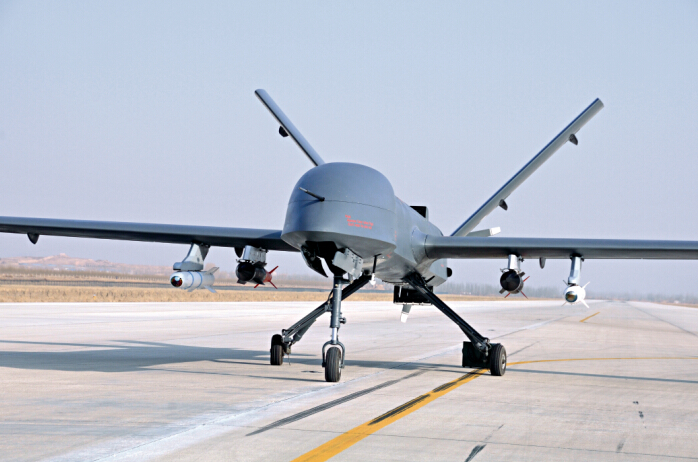By: Liang Xu
From the time of the first kinetic strike by an unmanned aircraft in October of 2001, the United States has relied heavily on remote-controlled drone technology for its relatively inexpensive loitering capabilities and the geographic reach it enables in the global war on terror. Over the years the US has slowly lost its monopoly on the use of military drones, with adversaries such as China now developing their own remotely controlled weapons and surveillance platforms, both for their own military and to export to countries that align with its national interests.
In response, the Trump Administration is reportedly nearing a decision to make it easier to sell U.S.-made military drones such as the MQ-1 Predator and MQ-9 Reaper overseas as part of the “Buy American” campaign. The campaign seeks to overhaul US arms export protocols in an effort to compete against fast-growing global rivals such as China, while countries such as Russia, Israel, Turkey, and South Korea are close behind. The changes in US export regulations are reportedly based on a desire to renegotiate the 1987 Missile Technology Control Regime an accord signed by the US and 34 other countries that set the rules for the sale and purchase of missiles. The focus of the renegotiations would allegedly be an alternative interpretation of what is defined as a missile the accord currently defines drones with a flight range over 185 miles and payload above 1,100 pounds as cruise missiles that require tight export controls.
A new definition that excludes certain drones as missiles would loosen the sale of unarmed intelligence, surveillance and reconnaissance systems equipped with high-resolution remote aerial monitoring and laser-guided targeting systems to aid missiles fired from other air, land, and sea assets. Countries that will likely be given fast-track sales to American drones are close NATO allies and partners in the “Five Eyes” intelligence alliance: Australia, Canada, New Zealand, and the United Kingdom. But other strategic allies, such as India and certain governments in the Middle East, are also likely to become eligible to purchase sophisticated US drones.
China, which is not a signatory to the 1987 accord, has seemingly taken advantage the American void in exporting drone technology to certain countries and quickly advanced to develop and export its own arsenal of unmanned aerial systems. What are the geopolitical implications of China becoming the primary alternative supplier of drones to countries both hostile and friendly to the United States? How does this proliferation differ from China simply incorporating its drone technology into its own military doctrine? Will China’s drones become the AK-47s of tomorrow? Since joining the military drone scene, China has grown into a world leader in the technology’s development, which could have strategic implications for the US foreign policy in flashpoint regions such as the South China Sea, and even around the globe.
First, what is China’s broader military doctrine? Unlike how drones fit into American military doctrine, which has largely surrounded monitoring and lethally striking non-state actors in countries outside of its immediate sphere of influence, Chinese military doctrine is much more confined to their region more specifically the Chinese mainland and disputed territories in the South China Sea. What’s more, their primary goal is to pursue anti-access/area denial (A2/AD) against a near-peer, if not conventionally superior, adversary the United States not dispersed networks of non-state actors. To meet this specific Chinese military challenge, Beijing has developed an arsenal of unmanned aerial systems ranging from stealthy combat drones to networked-drone swarms. While the U.S. military still remains superior in technology and in number of drones with the U.S. military reportedly operating some 7,000 and Chinese military operating at least 1,300 China is quickly gaining traction.
China’s CH-3 and Ch-4 are broadly modeled off variations of the U.S. Predator and Reaper drones. The next iteration, the CH-5, with a 4400-mile flight range over 60 hours soon to be 12,000 miles over 120 hours and payload of over one ton of weapons and sensors, including modules designed for electronic warfare and early warning radar to detect enemy aircraft, is the country’s most advanced drone to date. It can even communicate with other combat drones such as earlier CH-3 and CH-4 models to conduct joint missions. Similarly, the smaller CH-805 Stealth Target Drone, which can fly at near supersonic speeds to mimic Chinese fighters on air defense systems, would likely be used operationally as a wingman for manned aircraft.
Notably, however, China must tailor its military doctrine to engage a conventionally superior foe in the United States, who has prioritized expensive and highly advanced drone hardware such as the Global Hawk. For this reason China has sought to foster drones that will enable it an asymmetric capability an inexpensive attack force operating together and capable of quick though not decisive attacks. For this reason, Beijing has sought swarms of small, low-tech, possibly 3-D printable drones linked together through high-tech artificial intelligence to create a cognitive hive mind, or swarm.
For example, China’s SW-6 is a small “marsupial” drone with folding wings that can be dropped en mass from cargo chutes or helicopters to conduct persistent surveillance, jam enemy communications, or even relay friendly communications in contested airspace. While the drone is unarmed, it could network with other SW-6s to hunt, swarm, and even dive-bomb enemy targets. This would allow Beijing to project power within its sphere of influence with a lower probability of outright military confrontation the presence of unarmed drones do not trigger escalation in the same way that fighter jets or aircraft carriers do.
“Should a US warship all of sudden get swarmed by hundreds if not a thousand small unarmed drones, it could have disruptive and distracting effects impacting electronics and target acquisition for US weapons systems by blinding them,” says Doug Wise, former Deputy Director of the US Defense Intelligence Agency. “By having the nonlethal drone military capability, it also gives the Chinese a non-kinetic way to conduct military operations in the prosecution of the sovereign Chinese seas expedite control of a disputed island or interdict maritime traffic to control the waters.”
Part of the reason the Chinese military has likely kept its drones near the mainland could be a lack of space-based communications for over-the-horizon flight control where there is not a direct line of sight between the Chinese-based ground control and the drone. But China has already displayed an ability to do conduct such operations in a limited fashion, and as Beijing’s constellation of satellites grows, so will its ability to conduct remote operations in far off places where it has national interests, such as Africa and the Middle East, where drones could be launched from its new military base strategically positioned in Djibouti.
While drones might play a narrow asymmetric roll in Chinese military doctrine at the moment, the prominence of Chinese drone technology in defense trade shows suggests Beijing is also seeking to incorporate the technology into its broader foreign policy. Besides the United States, who has sold armed drones to the British and Italian militaries, China is the only other current exporter of lethal drones, providing them to governments with questionable human rights records, such as Pakistan, Iraq, Nigeria, Saudi Arabia, Egypt, the United Arab Emirates, and possibly even the Somali military. China is even building factories for its drones outside of its borders, in places like Saudi Arabia, Pakistan, and Myanmar, essentially bypassing plausible export restrictions all together. But while China is becoming a true competitor of the US in the provision of key weapons systems such as drones, it is also replacing Russia as the cheaper and less restricted alternative supplier. For example, a Chinese CH-4 drone costs a mere $4 million on the global market, while the MQ-1 Predator and ground station costs a reported $20 million.
“There are definite issues going on with restrictions on who we can and can’t sell to, but they are never the sole cause,” says Peter W. Singer, a Strategist and Senior Fellow at New America. “And sometimes those restrictions are pointed to as if somehow if they could get this law changed, or the interpretation of it changed, all would be good no. Essentially what is going on here is that China is offering itself up not just an alternative seller, but also an alternative seller of products that are comparable and cheaper. “ The implications of Chinese sales of drones go far beyond the lost of profit US defense firms might lose out on should they be restricted or outbid by Chinese competitors and there is little evidence to show that loosening the export controls on US systems will even make them more competitive on the global market. The true implications are that, unlike US use of drones in the far corner so the globe that rings of American imperialism, China is able to sidestep political backlash by turning to proxy nations to conduct its fights remotely through drone proliferation.
“When you are thinking about Chinese systems be it unmanned aerial systems or armed robotic tanks or warships you have to think about it in a framework that is not just about China,” says Singer. “It is akin to how the US military had to think about the implications of the spread of big fighter jets to surface-to-air missiles to AK-47s not just in the Red Army’s hand, but how they would be present in battlefields that the Russian weren’t serving in. And that is the same thing today when we look at the proliferation of these technologies.”







